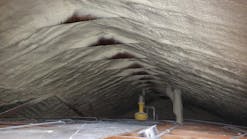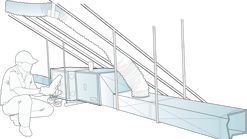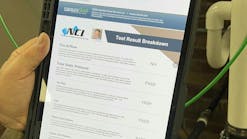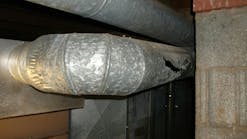You can best test and diagnose a residential hydronic heating system using pressure ports and balancing valves. However, few residential systems have either of these accessories. A commonly encountered hydronic system problem is the pipe sizing. Let’s take a look at how you can use a table and calculation to “see” if pipe size is causing your problem or not.
Equipment Rated BTU
Start with the equipment rated Btu output listed on the nameplate of the water heating equipment. Since many smaller systems have only one heating unit, you can use the rated BTU output of the equipment and the system rated temperature change (∆t) to determine the required system flow in gallons per minute (GPM).
In this sample diagnostic exercise, we’ll use an equipment output of 50,000 Btu and a 20⁰ F system ∆t.
System Required GPM
The core formula to calculate the amount of Btu moving through a system is BTU = GPM x ∆T x 500. The number 500 is a constant that comes from 8.33 pounds (the weight of one gallon of water) x 60 (number of minutes in an hour.) Use this formula when you calculate Btu/hour after the water flow and temperature have been measured.
To find the gpm needed for this system, we use a cousin to the BTU formula. It is GPM = BTU ÷ (ΔT x 500). When working this formula, the parenthesis means “do this part of the formula first.”
GPM = BTU ÷ (ΔT x 500)
Use the formula to find the required system gpm.
· GPM = 50,000 Btu ÷ (20⁰ F ∆t x 500).
· First multiply 20⁰ x 500 = 10,000.
· Then divide 50,000 by 10,000 to find 5 GPM
· This is the water flow needed to move the required Btu through this system.
Adjust the numbers in the formula to match the Btu and ∆t of any system you diagnose to find the required system gpm.
What Size Pipe is Needed?
Once you know the required system gpm, use a table to identify the pipe size needed to move the required gpm through the system.
Since the system we’re diagnosing must move five gpm, the table shows 3/4-in. copper tubing moves between 3.2 to 6.5 gpm. Five gpm falls within the appropriate mid-range flow. So, a 3/4” pipe would be the correct size.
Other tables and apps are available online for different piping materials and flows. Select a table or use the app matching the system type you are diagnosing to evaluate if the piping size matches the required gpm.
Pipe Sizing Solutions
Should the system we’re diagnosing contain 1/2” copper tubing to carry the five gpm flow, the piping would be undersized. In some cases, a re-pipe of the entire system may be required.
Aother solution may be to install a secondary dedicated piping circuit to and from a high gpm coil, radiator, or heat exchanger in the system. This will lower water flow through the existing piping to a flow matching the existing pipe size.
If in this scenario, the piping size is closer to the correct size, you may select and install a new pump to handle higher pressure and increase flow through the existing piping system and components. But that’s another article. Please let me know if you would be interested in how to resize a pump.
If your five gpm system had one-inch copper tubing, it is oversized. Excessive flow through a coil or heat exchanger may also reduce heat transfer. You can reduce flow with a balancing or ball valve.
If piping is oversized, offer your customers an additional coil or hydronic heater to service an area of the home that may not currently have adequate heating. This may evenly redistribute the load, increase comfort, and cost less than re-piping the entire system.
Additional Diagnostics pipe sizing diagnostics indicate the decline in the hydronic system’s performance is not due to incorrect pipe sizing, the following hydronic system inspections and repairs may lead you to a solution. You may hear air in the water gurgling through the system. Open the system bleeder valve to remove air in the piping. Look for it near the high point in the system.When opened, this small valve will sputter and leak air and some water until the noise levels decrease and the gpm throughout the system increases indicating the air has been successfully removed.
Low system flow may be due to a hard-to-find closed valve in the system. Locate the valve and open it. Then check its impact on the system.
The strainer (a hydronic system’s filter) may be restricted and need cleaning. Close the isolation valves, remove, clean, and replace the strainer to increase flow.
Many residential hydronic systems use multi-speed pumps. Make sure the pump is set to the correct pump speed to deliver the needed gpm.
The system may have become dirty and filled with sludge. Open a discharge or fill valve and inspect the fluid. When needed, flush the system, clean and replace the fluid with freshwater, appropriate water treatment chemicals, and glycol, as needed.
While some wet heads may be overflowing with experience and wisdom, many of you may be newcomers to hydronic system service and diagnostics. May the basic principles offered here increase your confidence to the point where you may be willing to dip your toe in the water this winter.
Rob “Doc” Falke serves the industry as president of National Comfort Institute, Inc., an HVAC-based training company and membership organization. If you're an HVAC professional interested in a free residential hydronic test and balance procedure, contact Doc at ncilink.com/ContactMe or call him at 800-633-7058. Go to NCI’s website at nationalcomfortinstitute.com for free information, articles, and downloads.











